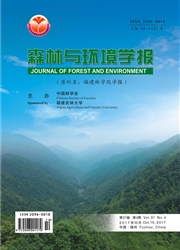

 中文摘要:
中文摘要:
以水热法和银镜法在木材表面制备出Ag-TiO2复合微纳米结构薄膜,并通过有机物氟硅烷修饰使木材表面具有超疏水性。采用场发射扫描电子显微镜(FE-SEM)、X射线衍射能谱(XRD)、傅立叶变换红外光谱仪(FTIR)和接触角测试等方法对木材表面进行了分析和表征。研究结果显示,经氟硅烷修饰后的Ag-TiO2负载的木材表面具有良好的紫外光驱动润湿性转换的特性,即光照前为超疏水性(152.8°)和亲油性(25°),光照一段时间后转变为超疏油性(150.2°)和亲水性(26.2°)。这是由于氟硅烷受到紫外光照射后会光致分解破坏一部分的烷基链,并在紫外光的激发下产生亲水基团所致。同时,与单纯TiO2负载的木材相比,Ag-TiO2复合薄膜中银纳米颗粒赋予了木材良好的抑菌性能,可提高木材的生物耐久性。以上研究为木材润湿性转换的智能化设计和多功能化设计开辟了新的途径。
 英文摘要:
英文摘要:
The micro-nano Ag-TiO2 composite film based on wood surface has been fabricated using hydrothermal synthesis and silver mirror method. Further modification of the treated wood surface with the organic material of fluoroalkyl silane led to a superhydrophobic surface. Field emission scanning electron microscopy( FE-SEM),X-ray diffraction( XRD),Fourier transform infrared spectroscopy( FTIR) and contact angle were used to characterize the wood surfaces. The results indicated that after modified with fluoroalkyl silane,the Ag-TiO2-coated wood surface possessed the good wettability conversion properties drived by UV light. That was,the modified wood surfaces were originally superhydrophobic( 152. 8°) and oleophylicity( 25°),and became superoleophobic( 150. 2°) and hydrophilicity( 26. 2°) after UV irradiation for a period of time. That could be due to the photo-decomposition of fluoroalkyl silane leading a destruction of alkyl chain and the production of hydrophilic groups under UV irradiation. Meanwhile,compared with the pure TiO2-coated wood,the Ag nanoparticles in the Ag-TiO2 composite film had also imparted excellent antibacterial property to wood,which could improve the biological resistance properties of wood. The findings have developed a new way for design of smart wood with switchable wettability and multifunctional wood.
 同期刊论文项目
同期刊论文项目
 同项目期刊论文
同项目期刊论文
 期刊信息
期刊信息
